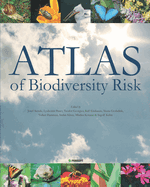Book discussion posts in the blog
The present Atlas of Biodiversity Risk is the first of its kind to describe and summarise in a comprehensive, easy-to-read and richly illustrated form the major pressures, impacts and risks of biodiversity loss at a global level. The main risks identified are caused by global climate and land use change, environmental pollution, loss of pollinators and biological invasions. The impacts and consequences of biodiversity loss are analyzed with a strong focus on socio-economic drivers and their effects on society. The Atlas is divided into sections which mostly deal with particular pressures. It is also based on case studies from a large set of countries, which are completed by introductory and concluding chapters for each section. Three scenarios of potential futures are the baseline for predicting impacts; the scenarios explore options for mitigating adverse effects at several spatio-temporal scales. Elements of these futures are modeled, tested and illustrated.
The Atlas combines the main outcomes of the large European project ALARM (performed by 68 partner organisations from 35 countries in Europe as well as from other continents) with some core results of numerous other research networks.
Josef Settele, Lyubomir Penev, Teodor Georgiev, Ralf Grabaum, Vesna Grobelnik, Volker Hammen, Stefan Klotz, Mladen Kotarac & Ingolf Kuhn (Eds) (2010)
Atlas of Biodiversity Risk. ISBN 978-954-642-446-4. Hardback, gross-format (310×360 mm), richly illustrated by maps, photos and figures, 300 pp. In English. Publication date: 22nd of May 2010.
Pre-publication price EUR 99.00
For more information on several discount options available by 31st of March 2010 look here!
Europe: surface mail delivery EUR 16, airmail delivery EUR 22;
Overseas: surface mail delivery EUR 19, airmail delivery EUR 26.
Table of contents | Sample pages | Larger cover | ORDER
Atlas of Biodiversity Risk. ISBN 978-954-642-446-4. Hardback, gross-format (310×360 mm), richly illustrated by maps, photos and figures, 300 pp. In English. Publication date: 22nd of May 2010.
Pre-publication price EUR 99.00
For more information on several discount options available by 31st of March 2010 look here!
Europe: surface mail delivery EUR 16, airmail delivery EUR 22;
Overseas: surface mail delivery EUR 19, airmail delivery EUR 26.
Table of contents | Sample pages | Larger cover | ORDER






Hierarchical Modeling and Inference in Ecology: The Analysis of Data from Populations, Metapopulations and Communities (Hardcover)
~ J. Andrew Royle (Author), Robert M. Dorazio (Author)
Key Phrases: spatial effects, occupancy dynamics, Web Supplement, Monte Carlo, Essentials of Statistical Inference (more…)
No customer reviews yet. Be the first.
List Price: $74.95
Price: $41.57 & this item ships for FREE with Super Saver Shipping. Details
You Save: $33.38 (45%)
A guide to data collection, modeling and inference strategies for biological survey data using Bayesian and classical statistical methods.
This book describes a general and flexible framework for modeling and inference in ecological systems based on hierarchical models, with a strict focus on the use of probability models and parametric inference. Hierarchical models represent a paradigm shift in the application of statistics to ecological inference problems because they combine explicit models of ecological system structure or dynamics with models of how ecological systems are observed. The principles of hierarchical modeling are developed and applied to problems in population, metapopulation, community, and metacommunity systems.
The book provides the first synthetic treatment of many recent methodological advances in ecological modeling and unifies disparate methods and procedures.
The authors apply principles of hierarchical modeling to ecological problems, including
* occurrence or occupancy models for estimating species distribution
* abundance models based on many sampling protocols, including distance sampling
* capture-recapture models with individual effects
* spatial capture-recapture models based on camera trapping and related methods
* population and metapopulation dynamic models
* models of biodiversity, community structure and dynamics
* Wide variety of examples involving many taxa (birds, amphibians, mammals, insects, plants)
* Development of classical, likelihood-based procedures for inference, as well as
Bayesian methods of analysis
* Detailed explanations describing the implementation of hierarchical models using freely available software such as R and WinBUGS
* Computing support in technical appendices in an online companion web site
Interessant
Mapping Species Distributions
Series: ECOLOGY, BIODIVERSITY AND CONSERVATION
Spatial Inference and Prediction
Janet Franklin
320 pages, 31 line figures, 6 tones, 20 tables.
Cambridge University Press
Softcover | 2010 | £34.99 | approx. $57/€40
Bio Maps of species' distributions or habitat suitability are required for many aspects of environmental research, resource management and conservation planning. These include biodiversity assessment, reserve design, habitat management and restoration, species and habitat conservation plans and predicting the effects of environmental change on species and ecosystems. The proliferation of methods and uncertainty regarding their effectiveness can be daunting to researchers, resource managers and conservation planners alike.
Franklin summarises the methods used in species distribution modeling (also called niche modeling) and presents a framework for spatial prediction of species distributions based on the attributes (space, time, scale) of the data and questions being asked. The framework links theoretical ecological models of species distributions to spatial data on species and environment, and statistical models used for spatial prediction. Providing practical guidelines to students, researchers and practitioners in a broad range of environmental sciences including ecology, geography, conservation biology, and natural resources management.
SPECIAL OFFER
Individual-based Modeling and Ecology
Series: PRINCETON SERIES IN THEORETICAL AND COMPUTATIONAL BIOLOGY
Volker Grimm and Steven F Railsback
428 pages, 12 halftones, 34 line illus, 3 tables.
Princeton University Press
Softcover | 2005 | £26.50 | approx. $43/€30
(reduced from £44.95 until 31/03/2010)
#154446 | ISBN-10: 069109666X
DescriptionImages (1)ContentsReviewsAuthor Bio Individual-based models are an exciting and widely used new tool for ecology. These computational models allow scientists to explore the mechanisms through which population and ecosystem ecology arises from how individuals interact with each other and their environment. This book provides the first in-depth treatment of individual-based modeling and its use to develop theoretical understanding of how ecological systems work, an approach the authors call "individual-based ecology."
Grimm and Railsback start with a general primer on modeling: how to design models that are as simple as possible while still allowing specific problems to be solved, and how to move efficiently through a cycle of pattern-oriented model design, implementation, and analysis. Next, they address the problems of theory and conceptual framework for individual-based ecology: What is "theory"? That is, how do we develop reusable models of how system dynamics arise from characteristics of individuals? What conceptual framework do we use when the classical differential equation framework no longer applies? An extensive review illustrates the ecological problems that have been addressed with individual-based models. The authors then identify how the mechanics of building and using individual-based models differ from those of traditional science, and provide guidance on formulating, programming, and analyzing models. This book will be helpful to ecologists interested in modeling, and to other scientists interested in agent-based modeling.
Volker Grimm is a Senior Researcher at the UFZ Centre for Environmental Research Leipzig-Halle and Lecturer at the University of Potsdam. Steven F. Railsback is a consulting scientist and Adjunct Professor of Mathematics at Humboldt State University.
Endorsement:
"This seminal book truly deserves to be called the founding text for the growing field of individual-based modeling and the broader program of individual-based ecology. Core procedures and standards for formulating, parameterizing, testing, and communicating such models have long been lacking. Even the basic definitions have been missing. In one stroke, Grimm and Railsback provide all of those things. Thus, individual-based modeling now has a foundation no less firm than the foundation of classical mathematical ecology."–Don DeAngelis, Biological Resources Division, U.S. Geological Survey, and University of Miami; author of Dynamics of Nutrient Cycling and Food Webs
A Complete Guide to Antarctic Wildlife: A Complete Guide to the Birds, Mammals and Natural History of the Antarctic (Hardcover)
by Hadoram Shirihai (Author), Brett Jarrett (Illustrator)
Monitoring Animal Populations and Their Habitats: A Practitioner's Guide
Brenda McComb, Oregon State University, Corvallis, USA; Benjamin Zuckerberg, Cornell University, Ithaca, NY, USA; David Vesely, Oregon Wildlife Institute, Corvallis, Oregon, USA; Christopher Jordan, Michigan State University, East Lansing, Michigan
Price: $89.95 $80.96
Cat. #: 7055X
ISBN: 9781420070552
ISBN 10: 142007055X
Publication Date: March 11, 2010
Table of Contents
Focuses on monitoring animal populations and their habitats
Presents comprehensive monitoring techniques of multiple species, communities, and landscapes
Provides guidance on how to set objectives, management goals, identifying trigger points for management changes, and demonstrating advantages of proper monitoring in management
Looks at monitoring from a national perspective drawing from a large pool of local, regional, and national examples of programs associated with monitoring animal populations
Discusses future directions in monitoring including occupancy modeling and estimation, information-theoretic approaches, spatial technologies, detection probabilities; and virtual data banks
Specifically address community based monitoring
Summary
In the face of so many unprecedented changes in our environment, the pressure is on scientists to lead the way toward a more sustainable future. Written by a team of ecologists, Monitoring Animal Populations and Their Habitats: A Practitioner’s Guide provides a framework that natural resource managers and researchers can use to design monitoring programs that will benefit future generations by distilling the information needed to make informed decisions. In addition, this text is valuable for undergraduate- and graduate-level courses that are focused on monitoring animal populations.
With the aid of more than 90 illustrations and a four-page color insert, this book offers practical guidance for the entire monitoring process, from incorporating stakeholder input and data collection, to data management, analysis, and reporting. It establishes the basis for why, what, how, where, and when monitoring should be conducted; describes how to analyze and interpret the data; explains how to budget for monitoring efforts; and discusses how to assemble reports of use in decision-making. The book takes a multi-scaled and multi-taxa approach, focusing on monitoring vertebrate populations and upland habitats, but the recommendations and suggestions presented are applicable to a variety of monitoring programs.
Lastly, the book explores the future of monitoring techniques, enabling researchers to better plan for the future of wildlife populations and their habitats. Monitoring Animal Populations and Their Habitats: A Practitioner’s Guide furthers the goal of achieving a world in which biodiversity is allowed to evolve and flourish in the face of such uncertainties as climate change, invasive species proliferation, land use expansion, and population growth.
CRC books
Some very interesting, monitoring, fire, habitat selection!!!
http://www.crcpress.com/ecommerce_product/browse_book_categories.jsf?category=AGR05B